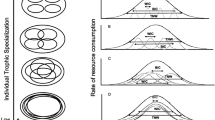Summary
Large orb-weaving spiders in temperate zones always mature in Autumn. A model based on laboratory feeding experiments and insect trap samples from an old-field in Michigan was used to simulate orb-weaver foraging behavior in various habitats and seasons. Seasons of peak energy return rates in habitats used by old-field orb-weavers indicate that prey availability plays a role in determining phenologies of large spiders. The minimum body-size to which the constraint applies in the model corresponds to the lower size-range of strictly Autumn-maturing orb-weaver species.
Similar content being viewed by others
References
Anderson JF (1970) Metabolic rates of spiders. Comp Biochem Physiol 33:51–72
Bristowe WS (1958) The World of Spiders. Collins London
Cantrall IJ (1943) The ecology of the Orthoptera and Dermaptera of the George Reserve, Michigan. Misc Publ Mus Zool Univ of Mich No 54
Enders F (1975) The influence of hunting manner on prey size, particularly in spiders with long attack distances (Araneidae, Linyphiidae, and Salticidae). Am Nat 109 (970):737–63
Ford MJ (1977) Energy costs of the predation strategy of a webspinning spider (Linyphiidae). Oecologia (Berl) 28(4):341–9
Gertsch WJ (1949) American spiders. Van Nostrand New York
Golley F (1961) Energy values of ecological materials. Ecology 42(3): 581–4
Haynes DL, Sisojevic P (1966) Predatory behavior of Philodromus rufus Walckenaer (Araneae: Thomisidae). Can Entomol 98:113–33
Heinrich B (1979) “Majoring” and “minoring” by foraging bumblebees, Bombus vagans: an experimental analysis. Ecology 60(2):245–55
Kaston BJ (1948) Spiders of Connecticut. Conn State Geol Nat Hist Surv Bull 70:1–874
Krebs JR, Ryan J, Charnov EL (1974) Hunting by expectation or optimal foraging? A study of patch use by chickadees. Anim Behav 22:953–64
Levi HW (1968) The spider genera Gea and Argiope in America (Araneae: Araneidae). Bull Mus Comp Zool 136(9):319–52
Levi HW (1970) The Diadematus group of the orb-weaver genus Araneus north of Mexico (Araneae: Araneida). Bull Mus Comp Zool 141(4):131–179
Levi HW (1971) The orb-weaver genera Singa and Hysosinga. Psyche 78(4):229–56
Levi HW (1973) Small orb-weavers of the genus Araneus north of Mexico (Araneae: Araneidae). Bull Mus Comp Zool 145(9):473–552
Levi HW (1974) The orb-weaver genus Zygiella (Araneae: Araneidae). Bull Mus Comp Zool 146(5):167–90
Levi HW (1974) The orb-weaver genera Araniella and Nuctanea (Araneae: Araneidae). Bull Mus Comp Zool 146(6):291–316
Levi HW (1975) The American orb-weaver genera Larinia Cercidia, and Mangora north of Mexico (Araneae:Araneidae). Bull Mus Comp Zool 147 (3):101–35
Levi HW (1976) The orb-weaver genera Verrucosa, Acanthepeira, Wagneriana, Acacesia, Wixia, Scoloderus, and Alpaida north of Mexico. Bull Mus Comp Zool 147(8):351–91
Levi HW (1977) The American orb-weaver genera Cyclosa, Metazygia, and Eustala north of Mexico (Araneae:Araneidae). Bull Mus Comp Zool 148(3):61–127
Levi HW (1977) The American orb-weaver genera Metepeira, Kaira, and Aculepeira north of Mexico (Araneae:Araneidae). Bull Mus Comp Zool 148(5):185–238
Levi HW (1978) The American orb-weaver genera Colphepeira, Micrathena, and Gasteracantha north of Mexico. Bull Mus Comp Zool 148(9):417–42
Levi HW, Berman JD (1971) The orbweaver genus Neoscona in North America (Araneae:Araneidae). Bull Mus Comp Zool 141(8):465–500
Olive CW (1979) Foraging Specialization in Orb-Weaving Spiders. Ph.D. Thesis. Michigan State University: East Lansing, Michigan
Olive CW (1980) Foraging Specializations in Orb-weaving Spiders. Ecology 61:1133–44
Schoener TW (1971) Theory of Feeding Strategies. Annu Rev Ecol Syst 2:369–404
Schoener TW (1969) Models of optimal size for solitary predators. Am Nat 103:277–313
Tolbert WW (1976) Population dynamics of the orb-weaving spiders Argiope trifasciata and Argiope aurantia (Araneus: Araneidae): Density changes associated with mortality, natality, and migrations. Ph D Thesis Univ of Tennessee, Knoxville, Tennessee
Turnbull AL (1962) Quantitative studies of the food of Linyphia triangularis Clerck (Araneae: Linyphiidae). Can Entomol 92:1233–49
Werner E Hall DJ (1974) Optimal foraging and the size selection of prey by the bluegill sunfish (Lepomis macrochirus). Ecology 55:1042–52
Author information
Authors and Affiliations
Rights and permissions
About this article
Cite this article
Olive, C.W. Optimal phenology and body-size of Orb-weaving spiders: Foraging constrains. Oecologia 49, 83–87 (1981). https://doi.org/10.1007/BF00376902
Received:
Issue Date:
DOI: https://doi.org/10.1007/BF00376902




